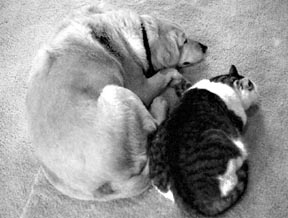Do you have a cat, or two, and would like to have a dog as well? Can they live together, peacefully? Nearly half of all pet homes have cats and dogs according to surveys by both the American Veterinary Medical Association and the American Pet Products Manufacturers Association.
Most people that come to Cornell for help have multi-species homes, says Emily Levine, DVM and animal behavior resident at the Cornell University Hospital for Animals. And I dont see them for problems between cats and dogs.
But dont assume just because many people live with cats and dogs that a peaceful relationship occurs instantly or naturally. People shouldnt expect immediate acceptance, says Dr. Levine. Its going to take time and work.
Move Over, Here Comes Rover
When researching possibilities for a new dog, remember that some breeds – like terriers or sighthounds – may have a higher prey drive and be more prone to chase or hunt a cat. Try to choose a dog with a temperament thats easy going and calm.
Does the new dog have prior – positive – experience with cats? This is usually an advantage. If possible, have the breeder or shelter worker test potential dog adoptees for relaxed behavior around cats. Has your cat met dogs without showing excessive fear or agitation? If not, ask a friend to help you introduce your cat to their dog from a safe distance.
Prepare a safe zone for your cat that is out of doggy limits. Put food, water, litter box and kitty toys where the dog cant get them. Make certain other areas of the house have high places where the cat can jump up and away to safety. You should prepare an area for the dog as well. Place his crate and bedding in this room. Separate the two pets spaces with baby gates and closed doors.
Take a cat-scented blanket or towel for your new dog to sniff before bringing him home. If possible, have a similar item that can be taken back to your cat. When both animals are in your home, continue swapping scented items. When we want to desensitize the animals to each other, we start with scent, Dr. Levine says. Watch how they respond. If the cats upset, she may slash her tail. A highly aroused dog may bark or whine. Keep switching the blankets until you dont see this behavior anymore.
Obedience train your dog and practice reinforcing commands such as sit, down and stay. The leave it command is especially helpful in teaching the dog to ignore your cat. Ive done extensive command-and-response training with my dogs, says Kathy Diamond Davis, author of Therapy Dogs: Training Your Dog to Reach Others. The cats learned to count on the dogs obeying, and that calmed them down.
Meeting Face to Face
Before beginning the introduction process, allow the new dog to explore his home with your supervision. Then confine him to his crate and room. Next, let your cat smell the area where your new companion has been. Allow each animal to smell the others scent on your hand and clothing.


288
First impressions are important. Introductions should be gradual and well controlled. Dont force the animals to be together. Avoid situations where the cat may want to run, thus triggering the dogs drive to chase prey. Meetings are all about supervision and control, and getting used to the new animals presence without confrontation, says Dr. Levine. Make sure the cat can get away and watch the dog from a safe distance. Make sure the dog doesnt lunge or bark at the cat.
The dog may also growl or seek out the cat if she attempts to hide. Normal defensive behaviors for your cat can include hissing or swatting. Even if they appear to be calmly interested in each other, the two species play differently and body language may be misinterpreted for aggression. They have different languages, explains Dr. Levine. We ask a lot of them not to fight but also to get along.
Crates and Positive Reinforcement
To facilitate first introductions, the dog may be crated or placed on leash with a training collar. The cat may also be crated while the dog is on leash or lying in a quiet down-stay observing her.
Another method is to counter-condition the dog with positive reinforcement. Try clicker training him to sit and stay, or turn his head away, Dr. Levine says. That way, the dog learns when hes lying down – and the cat is around – he gets his favorite treat.
Allow them to see and smell each other through baby gates or partially opened doors for short periods. Viewing intervals should be slowly increased, and of course supervised. Progress may be checked by offering your cat food, gradually moving it closer to where the dog is watching. If the cat is comfy, she will approach and eat, explains Levine.
If these introductions proceed well, the cat and dog may get together under your supervision. Until you are completely certain that both animals are safe with each other, keep them separated while you are away.
Fighting Like Cats and Dogs?
Just because youre excited about getting a new pet, says Dr. Levine, does not mean your current animal is happy about it. Despite proper preparation and introductions, you cant always predict how the animals will get along. Sometimes they become friends, sometimes they tolerate each others presence.
When we brought our Cavalier King Charles Spaniels into the house on leash to meet the cats, they hissed and swiped at them, immediately establishing their dominance over the dogs, says author of the Simple Solutions training books, Kim Campbell Thornton. The spaniels gave them a wide berth. Although I wouldnt call them buddies now, they will lie on the sofa together, sometimes even touching.
Although your cat should be able to assert her position, dont allow her to injure or frighten the dog. In some situations, no matter what you try, the cat and dog may not think their match was made in heaven. Dogs with strong instincts to hunt can seriously injure or even kill a cat. An exuberant, playful puppy may provoke a cat into a defensive swat.
Rarely, a cat may attack a dog, possibly wounding him. My fathers cat bullied my big Labrador. Shed hiss and smack him if he came in the door, says Sheila Webster Boneham, PhD, author of The Complete Idiots Guide to Getting and Owning a Dog.
Dr. Levine says, If one animal is terrorizing the other and the quality of that animals life is poor, intervention absolutely has to occur. She recommends starting with a thorough behavioral evaluation to see if modifications can be made or the environment altered. Anti-anxiety drugs may also be used to calm the victim or the aggressor.
Some owners may be able to keep the animals safely – and happily – separated from each other. But if you have a house where you cant separate them, the new animal may have to be re-homed.
Have a Plan B From the Beginning
One idea might include finding another person in advance who could take the animal if all efforts to integrate, or separate, the dog and cat fail. That way, the dog isnt dumped in a shelter. When re-homing the new animal – if you dont have a back-up home waiting – make every effort to return him to the breeder or place him with a qualified owner or rescue group.
When making the difficult decision of giving up one of the animals, be conscious of the status of your existing pet. The pet that was there first should take priority.
Before adopting your new dog, consider all the possibilities that you need to prepare for a positive and smooth introduction, Levine suggests, Too often people make last minute decisions and have unrealistic expectations that result in the dog being relinquished or abandoned.



